2008 FORD SUPER DUTY tow
[x] Cancel search: towPage 3 of 96
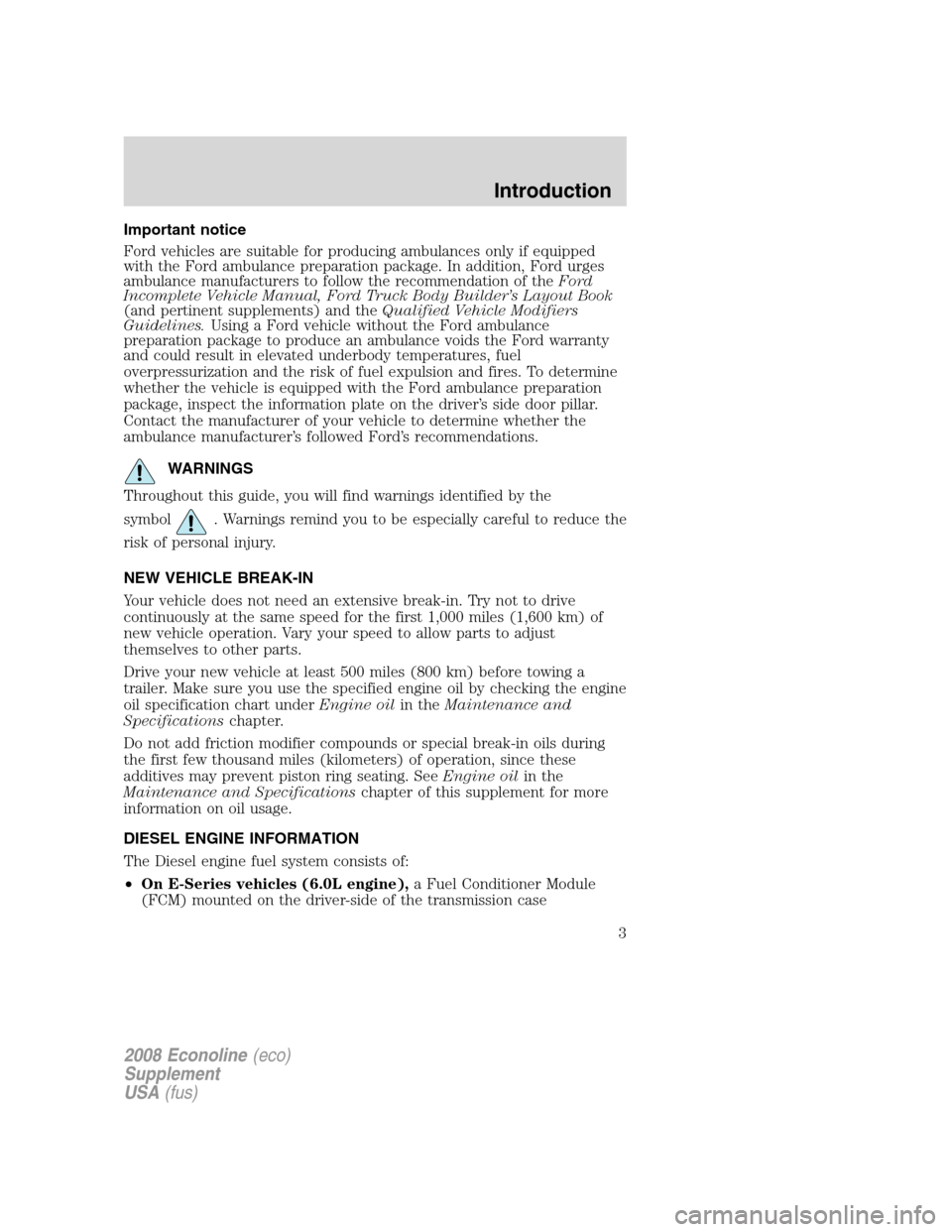
Important notice
Ford vehicles are suitable for producing ambulances only if equipped
with the Ford ambulance preparation package. In addition, Ford urges
ambulance manufacturers to follow the recommendation of theFord
Incomplete Vehicle Manual, Ford Truck Body Builder’s Layout Book
(and pertinent supplements) and theQualified Vehicle Modifiers
Guidelines.Using a Ford vehicle without the Ford ambulance
preparation package to produce an ambulance voids the Ford warranty
and could result in elevated underbody temperatures, fuel
overpressurization and the risk of fuel expulsion and fires. To determine
whether the vehicle is equipped with the Ford ambulance preparation
package, inspect the information plate on the driver’s side door pillar.
Contact the manufacturer of your vehicle to determine whether the
ambulance manufacturer’s followed Ford’s recommendations.
WARNINGS
Throughout this guide, you will find warnings identified by the
symbol
. Warnings remind you to be especially careful to reduce the
risk of personal injury.
NEW VEHICLE BREAK-IN
Your vehicle does not need an extensive break-in. Try not to drive
continuously at the same speed for the first 1,000 miles (1,600 km) of
new vehicle operation. Vary your speed to allow parts to adjust
themselves to other parts.
Drive your new vehicle at least 500 miles (800 km) before towing a
trailer. Make sure you use the specified engine oil by checking the engine
oil specification chart underEngine oilin theMaintenance and
Specificationschapter.
Do not add friction modifier compounds or special break-in oils during
the first few thousand miles (kilometers) of operation, since these
additives may prevent piston ring seating. SeeEngine oilin the
Maintenance and Specificationschapter of this supplement for more
information on oil usage.
DIESEL ENGINE INFORMATION
The Diesel engine fuel system consists of:
•On E-Series vehicles (6.0L engine),a Fuel Conditioner Module
(FCM) mounted on the driver-side of the transmission case
2008 Econoline(eco)
Supplement
USA(fus)
Introduction
3
Page 5 of 96
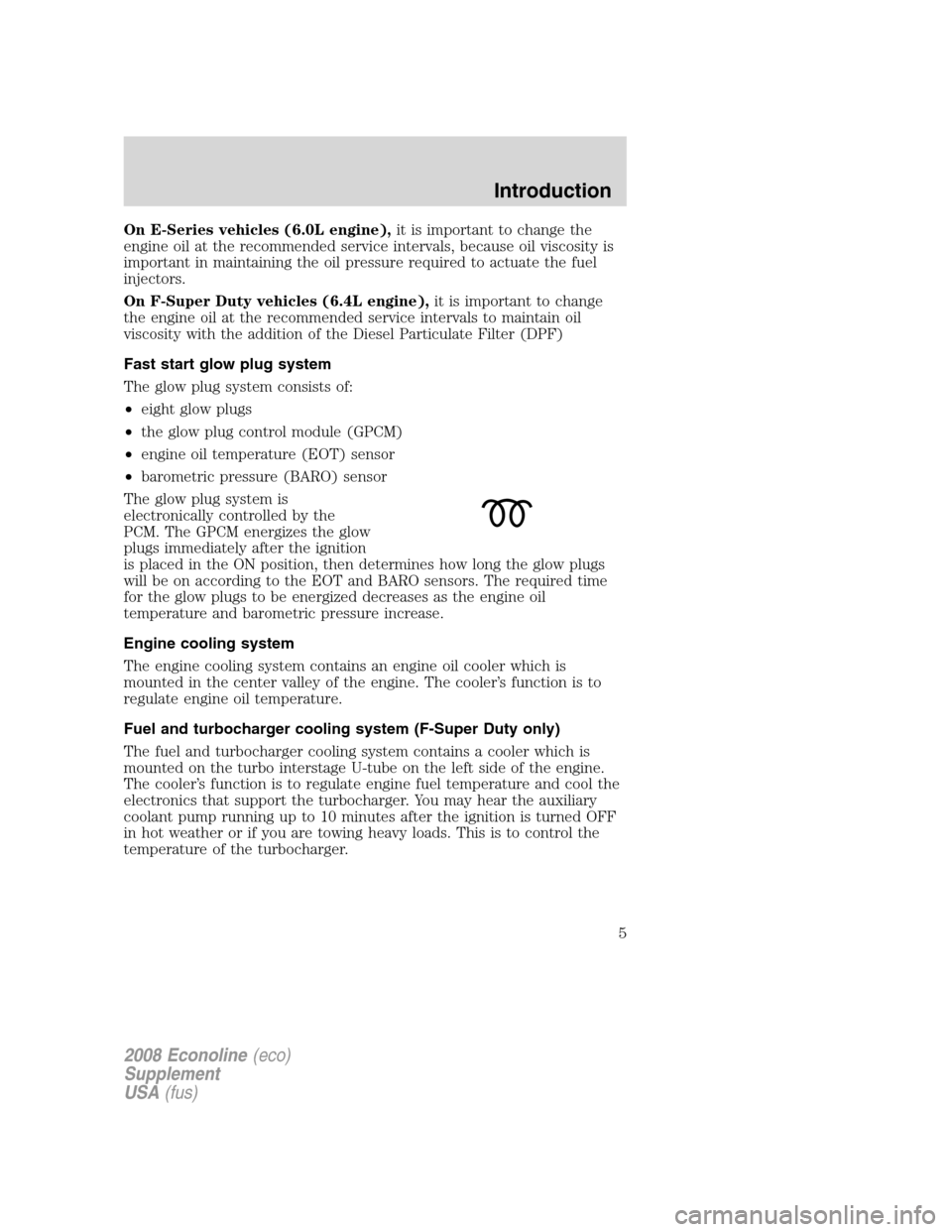
On E-Series vehicles (6.0L engine),it is important to change the
engine oil at the recommended service intervals, because oil viscosity is
important in maintaining the oil pressure required to actuate the fuel
injectors.
On F-Super Duty vehicles (6.4L engine),it is important to change
the engine oil at the recommended service intervals to maintain oil
viscosity with the addition of the Diesel Particulate Filter (DPF)
Fast start glow plug system
The glow plug system consists of:
•eight glow plugs
•the glow plug control module (GPCM)
•engine oil temperature (EOT) sensor
•barometric pressure (BARO) sensor
The glow plug system is
electronically controlled by the
PCM. The GPCM energizes the glow
plugs immediately after the ignition
is placed in the ON position, then determines how long the glow plugs
will be on according to the EOT and BARO sensors. The required time
for the glow plugs to be energized decreases as the engine oil
temperature and barometric pressure increase.
Engine cooling system
The engine cooling system contains an engine oil cooler which is
mounted in the center valley of the engine. The cooler’s function is to
regulate engine oil temperature.
Fuel and turbocharger cooling system (F-Super Duty only)
The fuel and turbocharger cooling system contains a cooler which is
mounted on the turbo interstage U-tube on the left side of the engine.
The cooler’s function is to regulate engine fuel temperature and cool the
electronics that support the turbocharger. You may hear the auxiliary
coolant pump running up to 10 minutes after the ignition is turned OFF
in hot weather or if you are towing heavy loads. This is to control the
temperature of the turbocharger.
2008 Econoline(eco)
Supplement
USA(fus)
Introduction
5
Page 11 of 96
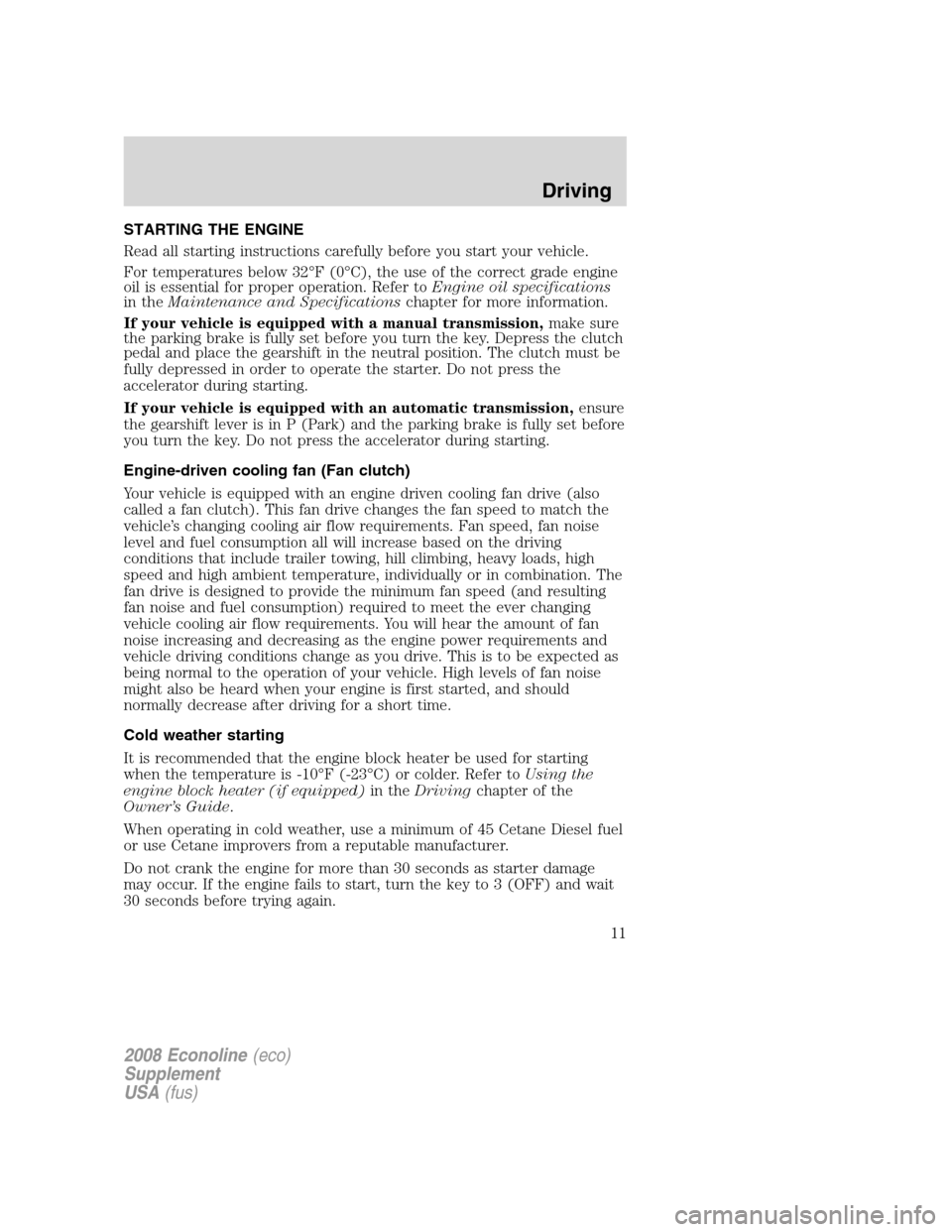
STARTING THE ENGINE
Read all starting instructions carefully before you start your vehicle.
For temperatures below 32°F (0°C), the use of the correct grade engine
oil is essential for proper operation. Refer toEngine oil specifications
in theMaintenance and Specificationschapter for more information.
If your vehicle is equipped with a manual transmission,make sure
the parking brake is fully set before you turn the key. Depress the clutch
pedal and place the gearshift in the neutral position. The clutch must be
fully depressed in order to operate the starter. Do not press the
accelerator during starting.
If your vehicle is equipped with an automatic transmission,ensure
the gearshift lever is in P (Park) and the parking brake is fully set before
you turn the key. Do not press the accelerator during starting.
Engine-driven cooling fan (Fan clutch)
Your vehicle is equipped with an engine driven cooling fan drive (also
called a fan clutch). This fan drive changes the fan speed to match the
vehicle’s changing cooling air flow requirements. Fan speed, fan noise
level and fuel consumption all will increase based on the driving
conditions that include trailer towing, hill climbing, heavy loads, high
speed and high ambient temperature, individually or in combination. The
fan drive is designed to provide the minimum fan speed (and resulting
fan noise and fuel consumption) required to meet the ever changing
vehicle cooling air flow requirements. You will hear the amount of fan
noise increasing and decreasing as the engine power requirements and
vehicle driving conditions change as you drive. This is to be expected as
being normal to the operation of your vehicle. High levels of fan noise
might also be heard when your engine is first started, and should
normally decrease after driving for a short time.
Cold weather starting
It is recommended that the engine block heater be used for starting
when the temperature is -10°F (-23°C) or colder. Refer toUsing the
engine block heater (if equipped)in theDrivingchapter of the
Owner’s Guide.
When operating in cold weather, use a minimum of 45 Cetane Diesel fuel
or use Cetane improvers from a reputable manufacturer.
Do not crank the engine for more than 30 seconds as starter damage
may occur. If the engine fails to start, turn the key to 3 (OFF) and wait
30 seconds before trying again.
2008 Econoline(eco)
Supplement
USA(fus)
Driving
11
Page 16 of 96
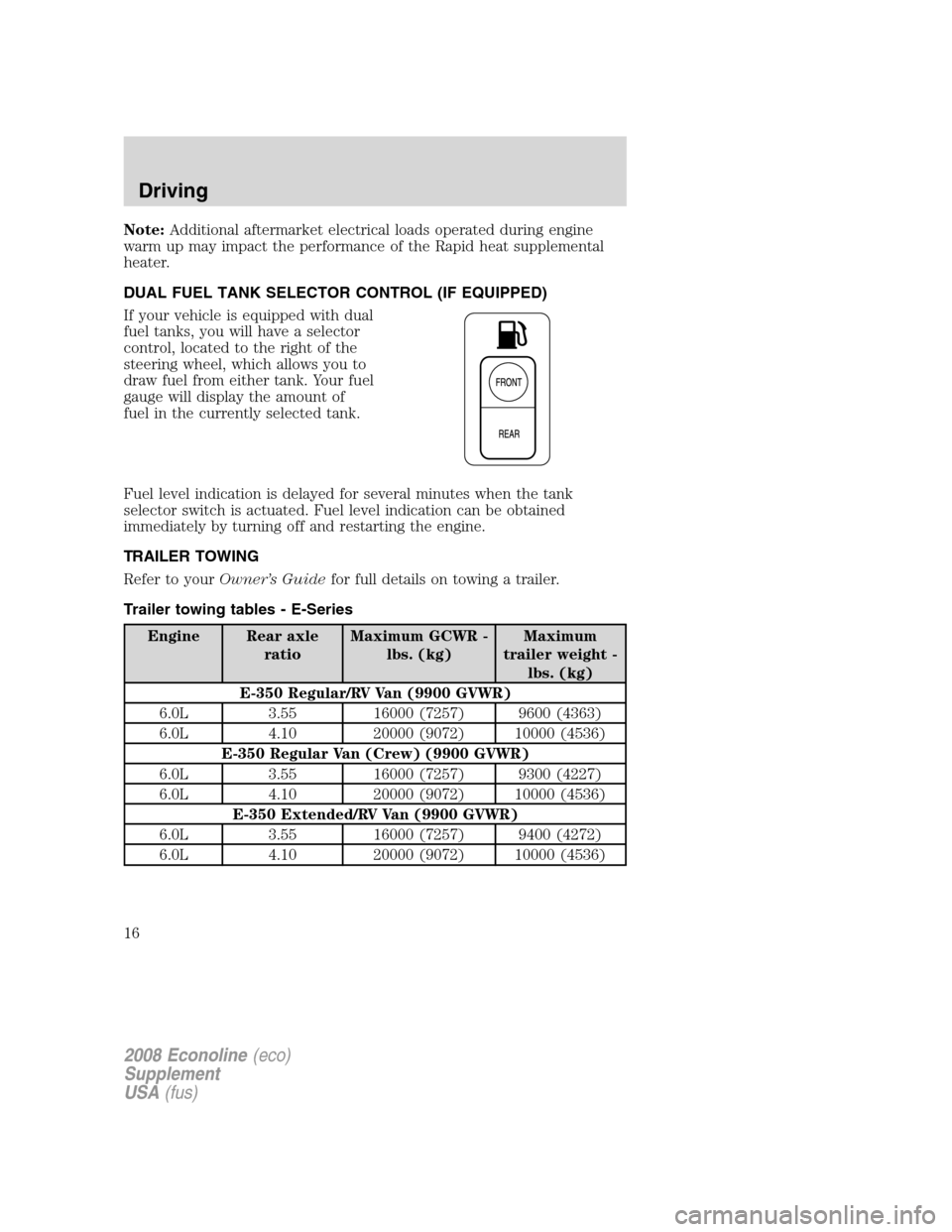
Note:Additional aftermarket electrical loads operated during engine
warm up may impact the performance of the Rapid heat supplemental
heater.
DUAL FUEL TANK SELECTOR CONTROL (IF EQUIPPED)
If your vehicle is equipped with dual
fuel tanks, you will have a selector
control, located to the right of the
steering wheel, which allows you to
draw fuel from either tank. Your fuel
gauge will display the amount of
fuel in the currently selected tank.
Fuel level indication is delayed for several minutes when the tank
selector switch is actuated. Fuel level indication can be obtained
immediately by turning off and restarting the engine.
TRAILER TOWING
Refer to yourOwner’s Guidefor full details on towing a trailer.
Trailer towing tables - E-Series
Engine Rear axle
ratioMaximum GCWR -
lbs. (kg)Maximum
trailer weight -
lbs. (kg)
E-350 Regular/RV Van (9900 GVWR)
6.0L 3.55 16000 (7257) 9600 (4363)
6.0L 4.10 20000 (9072) 10000 (4536)
E-350 Regular Van (Crew) (9900 GVWR)
6.0L 3.55 16000 (7257) 9300 (4227)
6.0L 4.10 20000 (9072) 10000 (4536)
E-350 Extended/RV Van (9900 GVWR)
6.0L 3.55 16000 (7257) 9400 (4272)
6.0L 4.10 20000 (9072) 10000 (4536)
2008 Econoline(eco)
Supplement
USA(fus)
Driving
16
Page 17 of 96
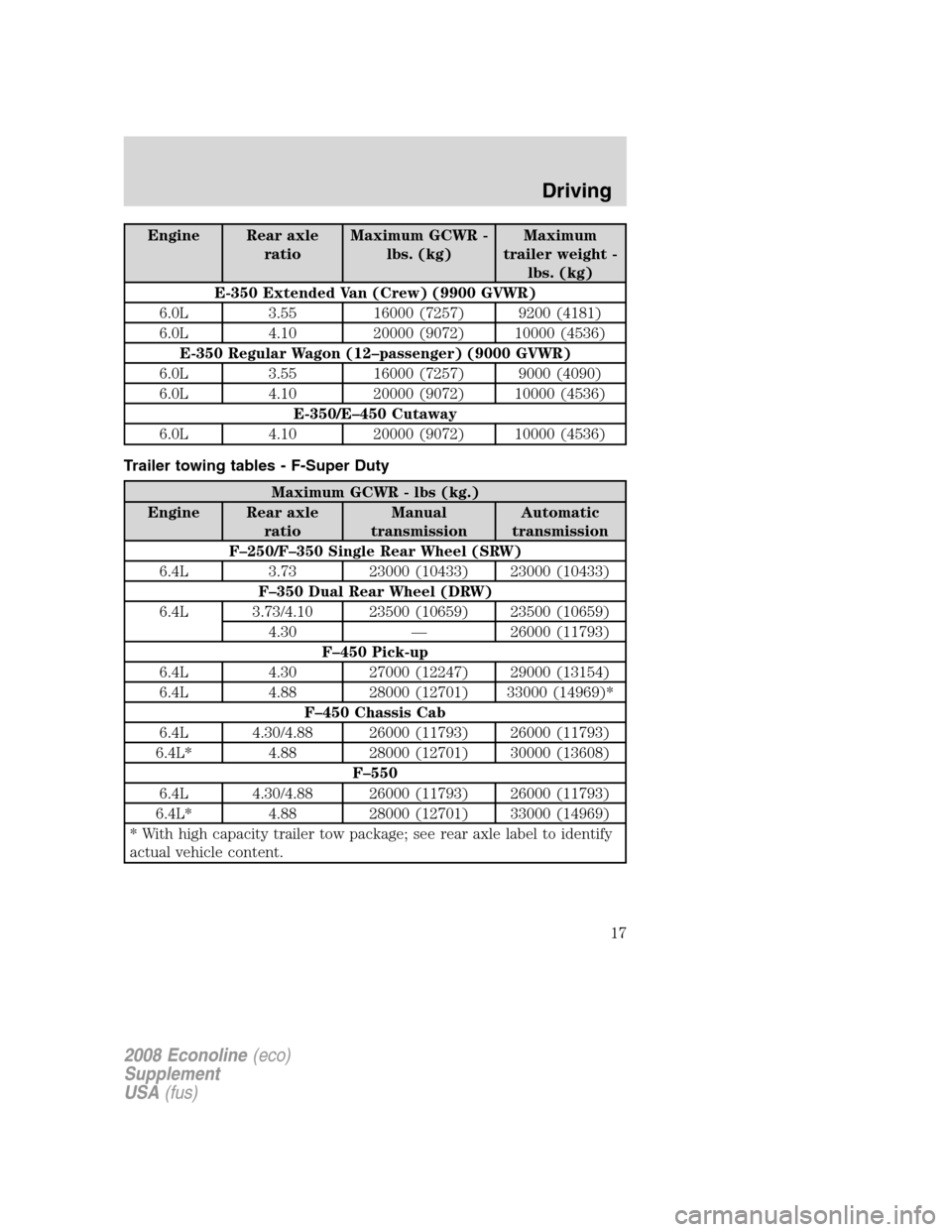
Engine Rear axle
ratioMaximum GCWR -
lbs. (kg)Maximum
trailer weight -
lbs. (kg)
E-350 Extended Van (Crew) (9900 GVWR)
6.0L 3.55 16000 (7257) 9200 (4181)
6.0L 4.10 20000 (9072) 10000 (4536)
E-350 Regular Wagon (12–passenger) (9000 GVWR)
6.0L 3.55 16000 (7257) 9000 (4090)
6.0L 4.10 20000 (9072) 10000 (4536)
E-350/E–450 Cutaway
6.0L 4.10 20000 (9072) 10000 (4536)
Trailer towing tables - F-Super Duty
Maximum GCWR - lbs (kg.)
Engine Rear axle
ratioManual
transmissionAutomatic
transmission
F–250/F–350 Single Rear Wheel (SRW)
6.4L 3.73 23000 (10433) 23000 (10433)
F–350 Dual Rear Wheel (DRW)
6.4L 3.73/4.10 23500 (10659) 23500 (10659)
4.30 — 26000 (11793)
F–450 Pick-up
6.4L 4.30 27000 (12247) 29000 (13154)
6.4L 4.88 28000 (12701) 33000 (14969)*
F–450 Chassis Cab
6.4L 4.30/4.88 26000 (11793) 26000 (11793)
6.4L* 4.88 28000 (12701) 30000 (13608)
F–550
6.4L 4.30/4.88 26000 (11793) 26000 (11793)
6.4L* 4.88 28000 (12701) 33000 (14969)
* With high capacity trailer tow package; see rear axle label to identify
actual vehicle content.
2008 Econoline(eco)
Supplement
USA(fus)
Driving
17
Page 18 of 96
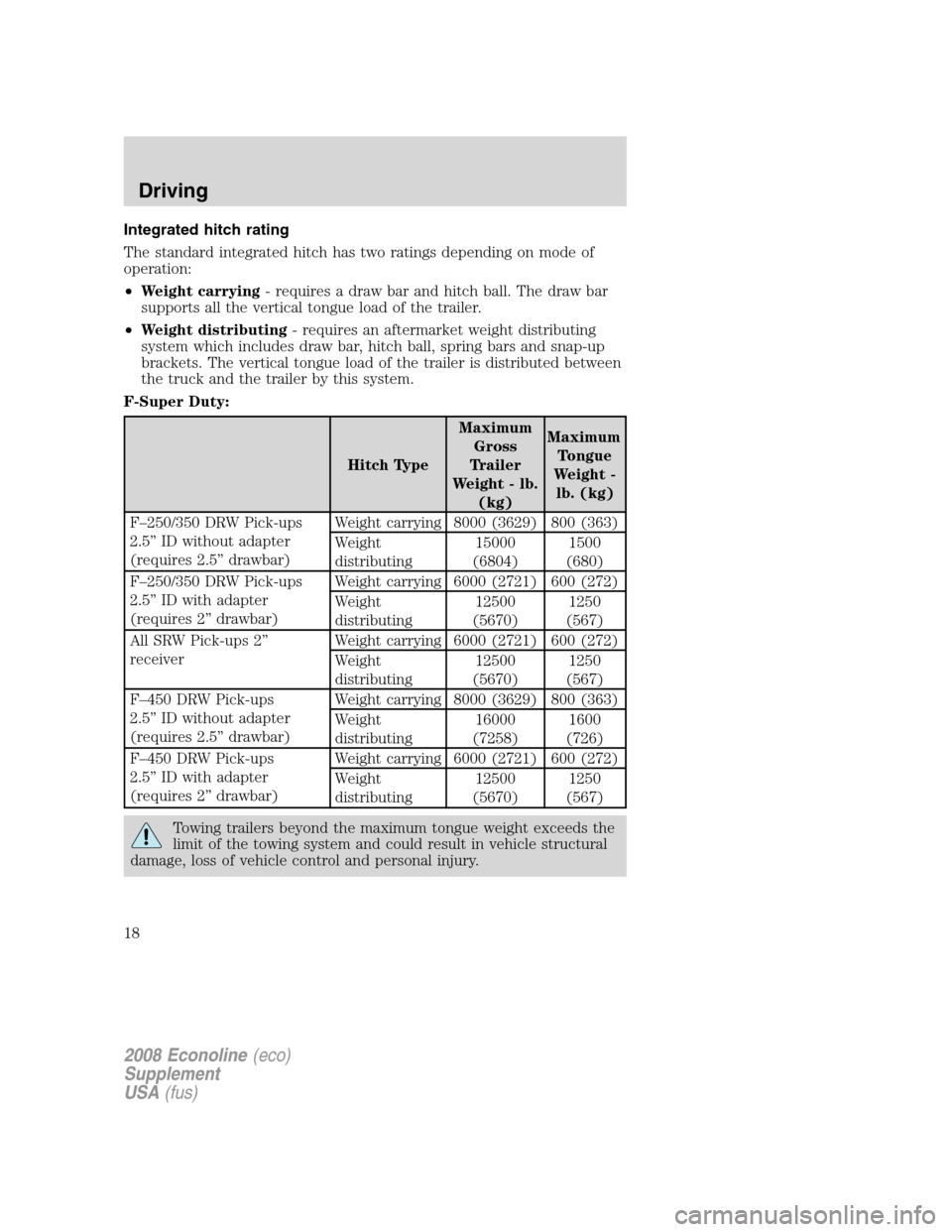
Integrated hitch rating
The standard integrated hitch has two ratings depending on mode of
operation:
•Weight carrying- requires a draw bar and hitch ball. The draw bar
supports all the vertical tongue load of the trailer.
•Weight distributing- requires an aftermarket weight distributing
system which includes draw bar, hitch ball, spring bars and snap-up
brackets. The vertical tongue load of the trailer is distributed between
the truck and the trailer by this system.
F-Super Duty:
Hitch TypeMaximum
Gross
Trailer
Weight - lb.
(kg)Maximum
Tongue
Weight -
lb. (kg)
F–250/350 DRW Pick-ups
2.5” ID without adapter
(requires 2.5” drawbar)Weight carrying 8000 (3629) 800 (363)
Weight
distributing15000
(6804)1500
(680)
F–250/350 DRW Pick-ups
2.5” ID with adapter
(requires 2” drawbar)Weight carrying 6000 (2721) 600 (272)
Weight
distributing12500
(5670)1250
(567)
All SRW Pick-ups 2”
receiverWeight carrying 6000 (2721) 600 (272)
Weight
distributing12500
(5670)1250
(567)
F–450 DRW Pick-ups
2.5” ID without adapter
(requires 2.5” drawbar)Weight carrying 8000 (3629) 800 (363)
Weight
distributing16000
(7258)1600
(726)
F–450 DRW Pick-ups
2.5” ID with adapter
(requires 2” drawbar)Weight carrying 6000 (2721) 600 (272)
Weight
distributing12500
(5670)1250
(567)
Towing trailers beyond the maximum tongue weight exceeds the
limit of the towing system and could result in vehicle structural
damage, loss of vehicle control and personal injury.
2008 Econoline(eco)
Supplement
USA(fus)
Driving
18
Page 36 of 96
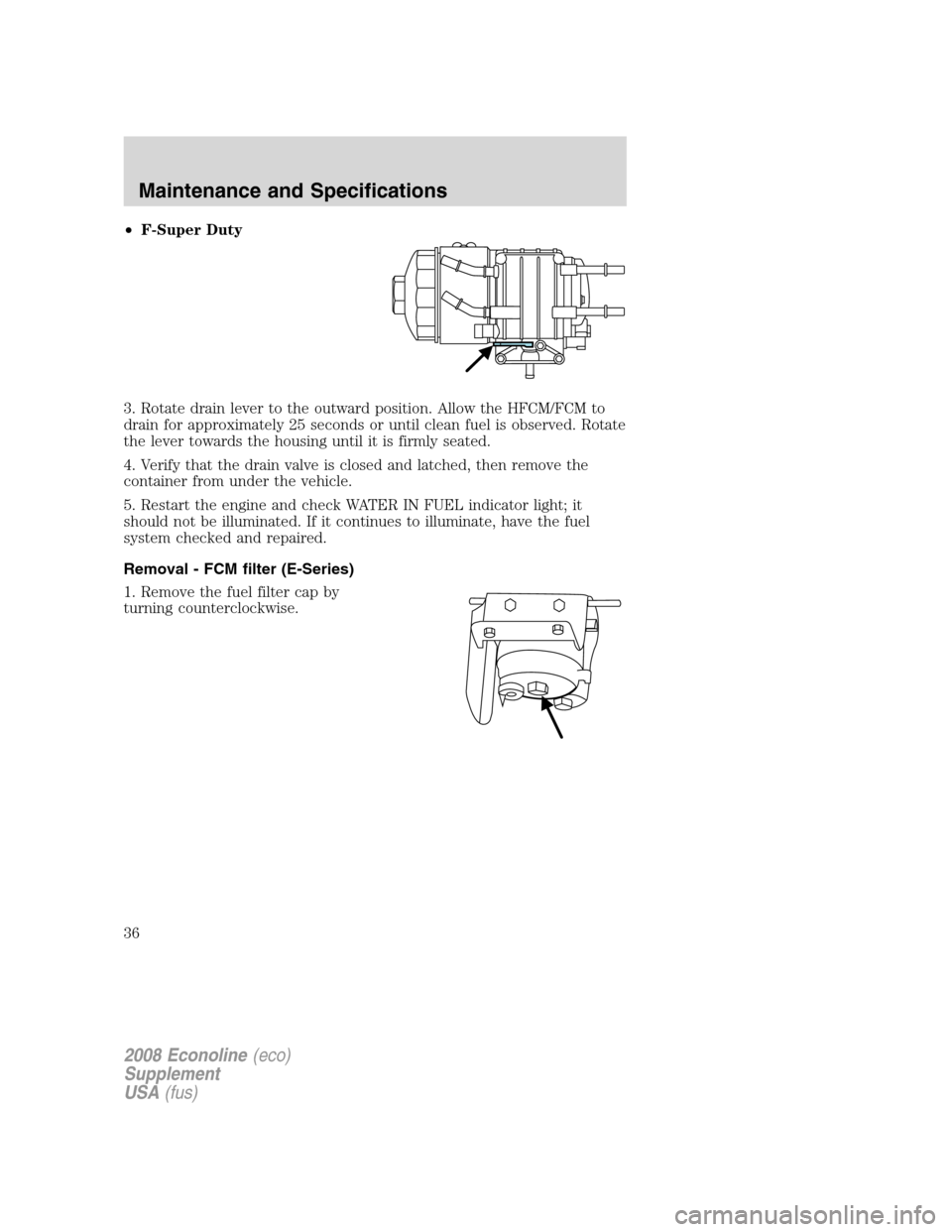
•F-Super Duty
3. Rotate drain lever to the outward position. Allow the HFCM/FCM to
drain for approximately 25 seconds or until clean fuel is observed. Rotate
the lever towards the housing until it is firmly seated.
4. Verify that the drain valve is closed and latched, then remove the
container from under the vehicle.
5. Restart the engine and check WATER IN FUEL indicator light; it
should not be illuminated. If it continues to illuminate, have the fuel
system checked and repaired.
Removal - FCM filter (E-Series)
1. Remove the fuel filter cap by
turning counterclockwise.
2008 Econoline(eco)
Supplement
USA(fus)
Maintenance and Specifications
36
Page 40 of 96
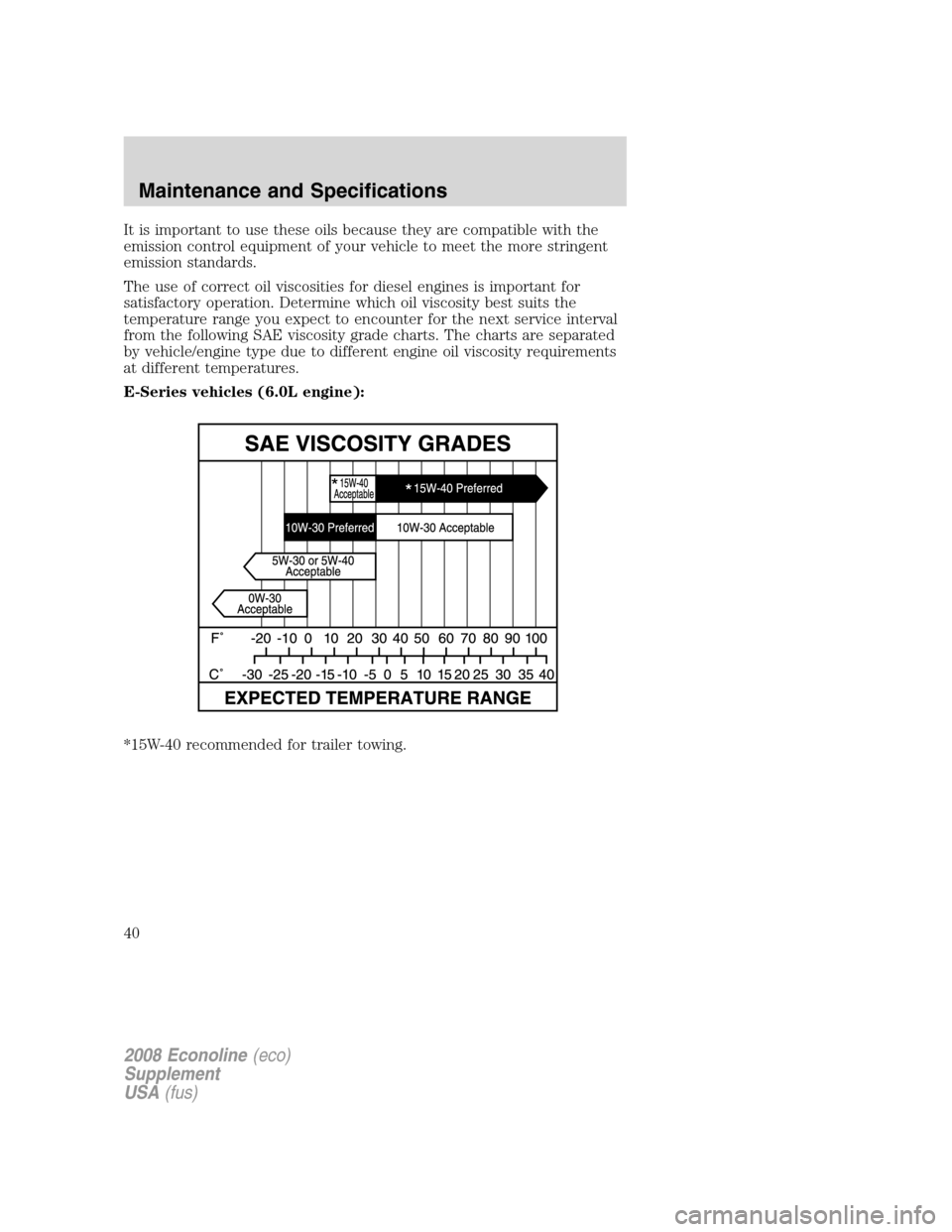
It is important to use these oils because they are compatible with the
emission control equipment of your vehicle to meet the more stringent
emission standards.
The use of correct oil viscosities for diesel engines is important for
satisfactory operation. Determine which oil viscosity best suits the
temperature range you expect to encounter for the next service interval
from the following SAE viscosity grade charts. The charts are separated
by vehicle/engine type due to different engine oil viscosity requirements
at different temperatures.
E-Series vehicles (6.0L engine):
*15W-40 recommended for trailer towing.
2008 Econoline(eco)
Supplement
USA(fus)
Maintenance and Specifications
40